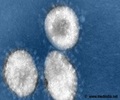Chung-I Wu of the University of Chicago ( an evolution specialist ), helped China's SARS Epidemiology Consortium analyze their findings .The consortium's research, genetically fingerprinted virus samples from several dozen infected people and animals from China and Hong Kong.
The work provides more evidence that SARS jumps from animals to humans, possibly frequently. And it suggests, that prompt control of new cases is crucial, before viral strains have much time to adapt to people.
The new study doesn't shed light on that question.However, it does suggest that the outbreak wasn't caused by a single species jump. Instead, the study says 11 people apparently were independently infected in the Pearl River Delta area of Guangdong Province beginning in November 2002 -- patients whose virus seems identical to viral samples found in some captive civets.
SARS underwent rapid genetic changes between November and the hospital-based infection, the study found, suggesting the mutations made person-to-person spread easier.
One of those mutated strains came to dominate the outbreak. The Chinese researchers linked that strain's first appearance to a patient who got sick in February -- and whose doctor a few days later traveled to Hong Kong and spread the virus in the Metropole Hotel, the launching pad for global spread.Then, mutations slowed for the remainder of the outbreak.
But last month, China reported the first of three new suspected SARS cases, and that patient was analyzed in the new study, too. His strain is much more similar to SARS found in civets than to any yet-documented human infection.
Specialist’s say , “ That's not proof a civet infected the man, rather it makes the continual looking for a reservoir host important .”








